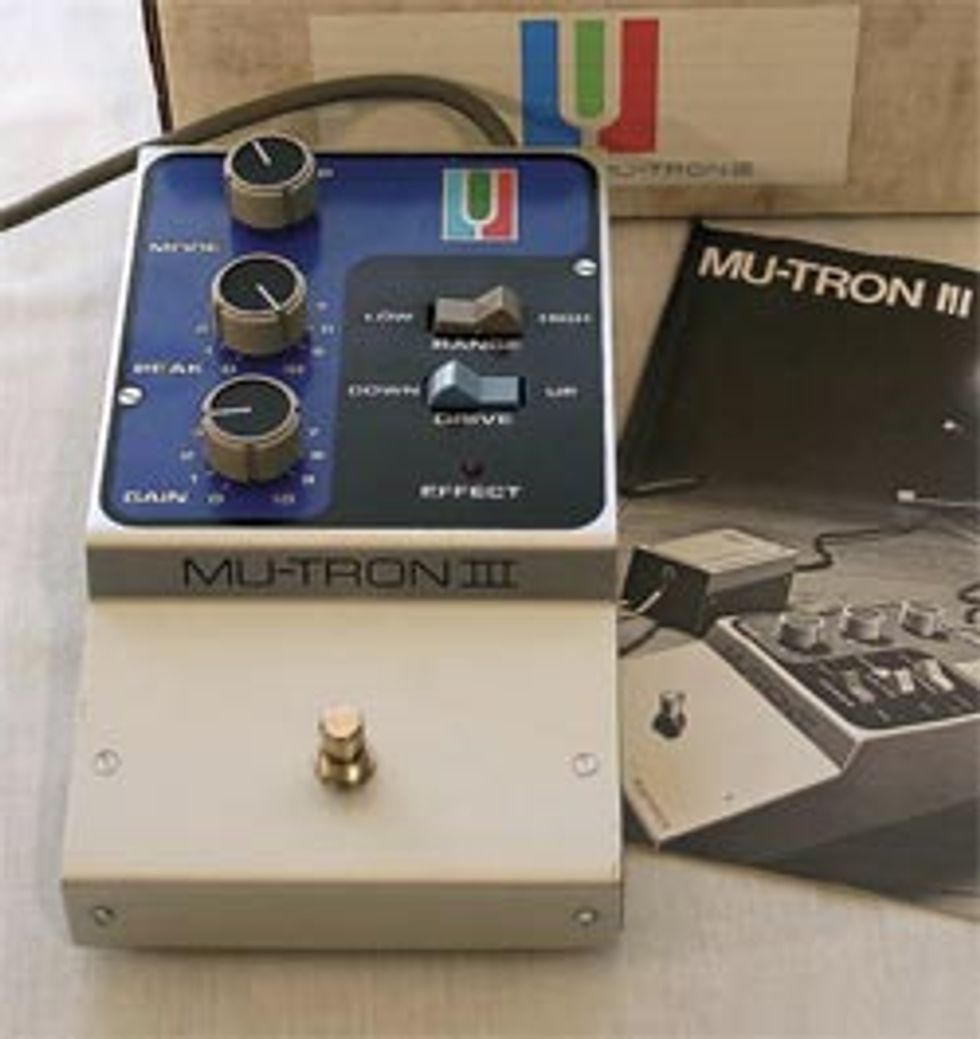Welcome back to Stomp School. This month, we’ll conclude our “Stompbox Classics” series with the biggest, baddest, funkiest envelope filter of all-time – the Mu-Tron III. Debuting in 1972,
 Welcome back to Stomp School. This month, we’ll conclude our “Stompbox Classics” series with the biggest, baddest, funkiest envelope filter of all-time – the Mu-Tron III. Debuting in 1972, Musitronic’s Mu-Tron III was the first stand-alone effects device of its kind, literally defining an entirely new category of effects and setting the standard for every envelope filter and auto-wah that was to follow – a standard many believe has yet to be matched.
Welcome back to Stomp School. This month, we’ll conclude our “Stompbox Classics” series with the biggest, baddest, funkiest envelope filter of all-time – the Mu-Tron III. Debuting in 1972, Musitronic’s Mu-Tron III was the first stand-alone effects device of its kind, literally defining an entirely new category of effects and setting the standard for every envelope filter and auto-wah that was to follow – a standard many believe has yet to be matched. The Musitronics Corporation of Rosemont, New Jersey was formed in 1972 in an attempt to salvage an aborted synthesizer project. The groundbreaking Mu-Tron III was the result. The unit was designed by Musitronics engineer and co-founder, Mike Beigel, using technology he had developed while designing a synthesizer for Guild Guitars. After Guild President Alfred Dronge was killed in a plane crash in 1970, the company made the decision to shut down their electronic division to focus strictly on guitars, abruptly pulling the plug on the Beigel’s synthesizer. When the Guild deal fell through, Beigel teamed up with Guild’s former chief engineer, Aaron Newman, to form Musitronics.
Newman approached Mike Beigel with the idea of developing a product based on the synthesizer project. So Beigel began working on the idea of making a product to generate synthesizer-like sounds without actually using a synthesizer. Extracting elements from one of his Guild prototypes called the Timbre Generator, Beigel came up with the Mu-Tron III, the first stand-alone envelope-controlled filter that could be used for any number of electric instruments. Beigel said he chose the envelope-controlled filter over other synthesizer elements, such as ring modulation, because it sounded more musical; it was a more general effect that would lend itself to a variety of applications, and it was easy to use.
The Mu-Tron III was an instant success, earning endorsements from jazz/fusion guitarist Larry Coryell, as well as Stevie Wonder, who used it on his Clavinet for the song “Higher Ground.” The pedal found favor with an eclectic variety of musicians playing in many diverse genres. Bootsy Collins used the Mu-Tron III on his bass with Parliament/ Funkadelic and Jerry Garcia made the Mu- Tron III part of his signature lead guitar sound with the Grateful Dead.
Inevitably, there were imitations and variations from nearly every other effects manufacturer, but none of them seemed to measure up to the mighty Mu-Tron in terms of features, versatility or sheer sonic superiority. Part of the reason lay in the fact that Beigel was successfully granted a patent for the circuitry of the Mu-Tron III. There were envelope filters and auto-wahs of all types, but to get the sound of the Mu-Tron, you had to get the Mu-Tron. Musitronics did license the Mu-Tron III circuitry to a few different companies in the seventies – the Univox Funky Filter and Monacor Effectmatic are notable examples of the Mu- Tron in disguise.
The original Mu-Tron III ran on 18V, using two 9V batteries; this gave it a wider dynamic range and more headroom. There was also the optional PS-1 power supply, with later versions featuring built-in AC power supplies. The Mu-Tron III also used opto-isolators to control the filter, which was novel for the time. This same method would also be used for the Mu-Tron Phasor II and Bi-Phase. The state variable filter in the Mu- Tron III allowed for low-pass, bandpass, and high-pass filter response, which could be triggered from low to high or vice versa. When ARP Instruments bought Musitronics in ‘79, they made the Mu-Tron line for about a year before going out of business, and the Mu-Tron III was no more. With the advent of the stompbox revival of the nineties, the Mu-Tron III became one of the big-ticket items for collectors and players alike. There was a reissue of sorts – the Mu-Tron III+ -- but inventor Mike Beigel says this is not an authorized version and the circuit is not exactly the same. Beigel did lend his expertise to Electro-Harmonix, creating an update of his original design, the Electro-Harmonix Q-Tron. The entire line of Mu-Tron effects has maintained a stellar reputation for superior sounds as well as rugged durability and great build quality, which is why they continue to command big bucks on the vintage market.
Well, that’s it for now. Hope you all enjoyed “Stompbox Classics.” Check in with us again next month to start your summer semester of Stomp School. Until then, keep on stompin’!
Tom Hughes
(a.k.a. Analog Tom) is the owner and proprietor of For Musicians Only (formusiciansonly.com) and author of Analog Man’s Guide To Vintage Effects. For Musicians Only is also the home of the FMO Gear Shop. Questions or comments about this article can be sent to: stompschool@formusiciansonly.com
Analog Man
(analogman.com) is one of the largest boutique effects manufacturers and retailers in the business, established by “Analog” Mike Piera in 1993. Mike can be reached at AnalogMike@aol.com

